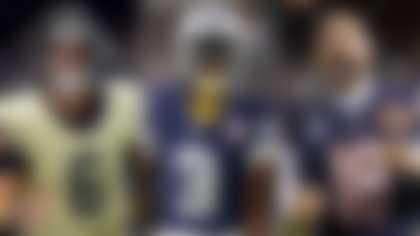Former NFL player and scout Bucky Brooks knows the ins and outs of this league, providing keen insight in his weekly notebook.
STEVE SMITH: What he taught me about scouting wide receivers.
When Steve Smith hinted that he might be playing his last NFL gamein Week 17, the football world began the coronation of an illustrious career that could end in a Hall of Fame enshrinement.
Why not?
Smith will leave the game with an impressive résumé that, heading into Week 17, included 14,697 receiving yards (seventh all-time), 1,028 receptions (12th) and 81 receiving touchdowns (tied for 25th). If that's not enough, in 2005, he became one of only three receivers -- including Jerry Rice (1990) and Sterling Sharpe (1992) -- to earn the receiving "Triple Crown," leading the NFL in receptions (103), receiving yards (1,563) and receiving touchdowns (12). Throw in eight 1,000-yard seasons, five Pro Bowl berths and a pair of All-Pro nods, and it's clear that Smith has created quite a legacy as one of the most explosive pass catchers in NFL history.
From a personal standpoint, Smith will always be the standard I use when projecting a young receiver's potential as a pro. When I got into the scouting business as an area scout for the Seattle Seahawks in 2000, I covered the Mountain West Conference as part of my territory, and the University of Utah fell on my list of schools. Thus, I had a chance to evaluate Smith during his final season with the Utes.
Measuring 5-foot-9 and 184 pounds with sub-4.4 speed and exceptional short-area quickness, Smith averaged 21.2 yards per catch for the Utes as their designated big-play receiver. He torched opponents on vertical routes, but he also displayed fantastic skills as a catch-and-run specialist on the perimeter. He had a knack for making defenders miss in traffic, which made sense, given his success as a punt returner. (Smith finished his collegiate career with a punt-return average of 11.9 yards and four total return touchdowns.) Based on his speed and production as a deep-ball threat/return specialist, I slapped a fourth-round grade (developmental prospect/special teams standout) on Smith at the end of the college season.
I continued to give Smith solid marks as a developmental prospect after watching him dominate the college all-star game circuit (the Blue-Gray Game, Hula Bowl and East-West Shrine Game) as a feisty playmaker with explosive return skills and big-play ability. He not only made his mark in games, but he owned defenders in one-on-one and team drills. With Smith looking like a natural as a returner, I thought he could carve out a nice career as a specialist until he could refine his game enough to be a productive WR3 early in his career.
To be honest, my projections were based heavily on Smith's skills as a punt returner. As a young scout, I was encouraged to find receivers with punt-return experience in their backgrounds because then-Seahawks coach Mike Holmgren and offensive coordinator Gil Haskell believed ex-returners possessed the toughness and running skills to succeed as playmakers on the perimeter in a pro-style passing game that placed a significant emphasis on "YAC" (yards after catch).
This philosophy was based on their experiences with the San Francisco 49ers (Holmgren coached Jerry Rice and John Taylor as the team's QB coach/offensive coordinator in late 1980s/early 1990s) and Los Angeles Rams (Haskell worked with Henry Ellard as the team's special teams coach in 1980s), as well as their collective experience with the Green Bay Packers in the 1990s developing the likes of Robert Brooks, Antonio Freeman and others who became productive wide receivers after entering the league as part-time return specialists. (I played under Holmgren and Haskell during parts of the 1995, '96 and '97 seasons as a WR/DB/KR.)
We didn't select Smith in the 2001 NFL Draft, partially due to concerns about his size (the Seahawks preferred "big" receivers or pass catchers that measured 5-foot-10 or taller) on the perimeter, but I paid close attention to his growth as a player. He immediately garnered Pro Bowl honors as a rookie returner for the Carolina Panthers on the strength of three return scores (two kick returns and a punt return).
In 2003, I got a chance to witness Smith's development first-hand when I joined the Panthers as an area scout. I watched Smith as a WR2 opposite Muhsin Muhammad in a run-heavy offense that featured the diminutive pass catcher as a vertical threat. At the time, he ran a small portion of the route tree (go route, post route, dig, comeback and quicks), but I was immediately impressed with his combination of speed, quickness and burst. It is uncommon to find a speed receiver with the balance, body control and agility to get in and out of breaks as a polished route runner. Smith was one of the few receivers who could roll into cuts or make hard plants to separate from defenders. This allowed him to incorporate a variety of creative releases and stems in his routes to consistently get open against tight coverage.
While Smith's creativity needed to be harnessed to keep him on the same page as the quarterback, he became a matchup problem as a WR2. This was evident during the Panthers' 2003 Super Bowl run, when Smith delivered a number of big plays, including his 69-yard game-winning touchdown against the Rams in the NFC Divisional Round.
Aside from Smith's creativity and explosiveness, I was impressed with his ability to play above the rim as an undersized receiver. He routinely won 50-50 balls down the field against defenders along the boundary on back-shoulder fades. The knock against using smaller receivers as WR1s typically involved their inability to make plays in traffic; Smith's athleticism and leaping ability (with a 38.5-inch vertical) allowed him to function at a high level as the primary target.
Interestingly, Smith finally got his chance to be a No. 1 receiver in 2005 after bouncing back from a devastating leg injury the previous season and watching Muhammad depart Carolina as a free agent. He surprised most observers inside and outside of the building with his ability to dominate on the perimeter as a "one-man show" in the passing game. Without a credible threat on the backside, Smith captured the "Triple Crown" and sparked the team's run to the NFC Championship Game.
By definition, WR1s must be able to put up big numbers against double coverage, and Smith has spent the latter part of his career defeating various brackets and rolled coverage. This is when I discovered elite receivers should be unstoppable -- there is no excuse for them to disappear for extended periods. Smith excelled despite suspect quarterback play and the lack of a stellar supporting cast on the perimeter. (Yes, I know Jake Delhomme was a Pro Bowl selectee for the 2005 season, but let's be real: He wasn't ever considered an elite QB in league circles.)
Most impressively, Smith continued to get better as an older player, despite losing some of his trademark speed and explosiveness. He learned how to control his pace and tempo during routes, and he became a more detailed route runner as he evolved into a possession receiver during his mid-30s. On the surface, this doesn't appear to be a major development, but I can assure you that most "speed" receivers are unable to sustain a high level of play when their fastball disappears. It's hard for athletic freaks to master the nuances of route running when they've spent the majority of their careers simply running past defenders utilizing their speed and explosiveness.
That's why Smith's evolution as a receiver provides a bit of a blueprint on how to evaluate and develop young receivers. Scouts must look beyond the measurables and evaluate the player's total game when assessing talent. Moreover, evaluators should pay closer attention to how a player approaches practice when they conduct a school visit or check out veterans in training camp. Smith worked harder than any receiver on the field, and he treated each rep as a game-like competition, particularly one-on-ones and team drills.
Now, I have to acknowledge Smith's missteps as a teammate during his time with the Panthers (Smith was suspended on multiple occasions for altercations with teammates) because they are an important part of his journey. But his maturation since those incidents shows scouts that guys are capable of changing, given time and support. Although coaches love players who exhibit passion and energy on the field, they must help red-line players learn how to keep their emotions in check in critical moments. As Smith evolved throughout his time with the Panthers and Ravens, he learned how to harness his emotions and become the kind of leader every team needs.
With Smith's development as a playmaker and leader embedded in my mind, I think I have a greater appreciation for what to look for in a championship player.
Follow Bucky Brooks on Twitter @BuckyBrooks.











